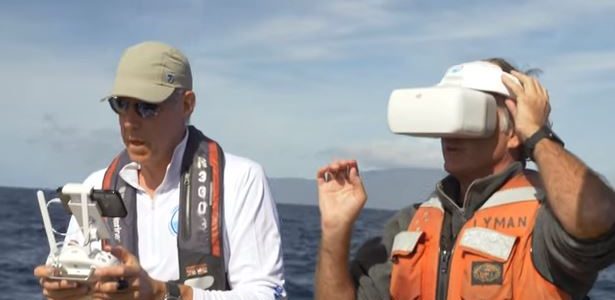Every fall, pods of enormous humpback whales make their way towards Hawaii, where they can ride out the winter in warm waters of NOAA’s Hawaiian Islands Humpback Whale National Marine Sanctuary. For centuries humans have watched this noble migration with awe and wonder. But today, an ever-growing number of these amazing animals are finding themselves in grave danger, entrapped in fishing gear and other marine debris.
Specialists from the National Oceanic and Atmospheric Administration (NOAA) have worked with local volunteers to help save the whales by launching small boats with trained teams to disentangle them while in the water. It’s risky work, bringing people into close contact with the gigantic mammals. Knives on long poles work to cut free ropes that have sunk deep into the whales flesh. Last year, a volunteer was killed when a whale struck him.
To help make the process safer, the whale rescue squads are turning to a new technology: drones.
Matt Pickett, a former NOAA sanctuary manager, is now the founder of Oceans Unmanned, a non-profit organization that facilitates the use of drone technology for marine conservation. Oceans Unmanned recently unveiled the freeFLY program, a new initiative designed to provide aerial support using small drones for large whale entanglement response efforts.
“In the past, we had to get close to the whales at least three times,” explains Pickett. “Once to figure out where the animal was entangled, once to cut them free, and once to make sure the job was done right and nothing was left behind.”
With drones, the team can cut that down to just one step. Using small, remote controlled quadcopters with powerful cameras they can do their initial assessment and final check. “It makes the entire process much safer for both the humans and the whales.”
Oceans Unmanned recently worked with DJI to document the way drone technology is being used to help save entangled whales. Interviews and additional quotes are available from NOAA, Oceans Unmanned, and DJI. Video footage is also available for broadcast media without graphic overlays or music.
“Imagery of whales taken by UAS platforms and those depicting rescue activities were conducted pursuant to and under the oversight of NOAA Fisheries’ Marine Mammal Health and Stranding Response Program (Permit Numbers 932-1905 and 18786.) Permits were issued under the authority of the Marine Mammal Protection Act and the Endangered Species Act.”



















